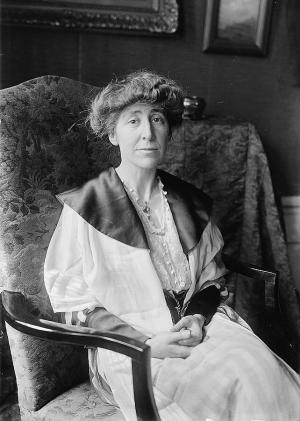Congresswoman Jeannette Rankin

This lesson explores the life and political activism of Congresswoman Jeannette Rankin, one of the most overlooked activists in American history. Starting in the Progressive Age, students will also examine her votes during WWI and WWII, and her opposition to the Vietnam War. Students will corroborate evidence through primary sources written by Rankin and others in her life to determine her core values. Ultimately, the summative assessment will be a creation of a textbook entry for Congresswoman Rankin, as she is often overlooked in history.
1-2 class periods
- Students will corroborate primary and secondary sources to better understand the values, sentiments, and political beliefs of Jeannette Rankin
- Students will understand Jeannette Rankin as an activist who was not only a pacifist, but advocated for those who were the most vulnerable and oppressed in 20th century America.
- Students will create a textbook entry to showcase what they have learned about Jeannette Rankin.
Students should understand that while largely ignored by mainstream textbooks, Jeannette Rankin was the first female Congresswoman in United States history, a Republican from Montana, Progressive and the only Congressperson to vote against both World War I and World War II.
Do Now: Running on an isolationist and Progressive platform, Jeannette Rankin from Montana, became the first woman to serve in Congress, elected in 1916. Please pick one and respond.
- How do you think Jeannette Rankin’s gender influenced her political behavior in Congress, if at all? Why?
- Did Congresswoman Rankin have an obligation to specifically represent women’s issues, as the only female member, in Congress? Why or why not?
Discuss Do Now.
- Inform students they are going to be look at primary and secondary sources (pg 3-10) to determine the worldview and ideology of Congresswoman Rankin to establish connections across the four time periods in her life (Pre-Congress, WWI, WWII, and Post-WWII).
- Distribute evidence gathering sheet (pg 11). Allow students to work in groups of four with one student completing each section.
- After each student has completed their section, have students share out with their group and allow students to identify themes and complete the “Bringing It All Together!” question.
- Conclude with Think-Pair-Share practice with one of the following questions (teacher discretion)
- What were the values of Congresswoman Rankin? Be sure to provide direct evidence from the texts and activities today.
- Why do you think Americans, if they know her at all, only focus on WWI and WWII, and not her other activism?
- Do you agree or disagree with her votes in World War I and World War II? Why or why not?
- Why do you think she has largely gone forgotten in American history?
Take out a US History textbook and showcase the lack of Congresswoman Rankin in the textbook. If time is remaining, have students evaluate whether she should be more present or not in the textbook.
For homework, students will write a two-three paragraph response to be taped into our textbook (See Page 12 for assessment)
D2.His.4.9-12.
Analyze complex and interacting factors that influenced the perspectives of people during different historical eras.
CCSS.ELA-LITERACY.RH.11-12.1
Cite specific textual evidence to support analysis of primary and secondary sources, connecting insights gained from specific details to an understanding of the text as a whole.
CCSS.ELA-LITERACY.RH.11-12.2
Determine the central ideas or information of a primary or secondary source; provide an accurate summary that makes clear the relationships among the key details and ideas.
